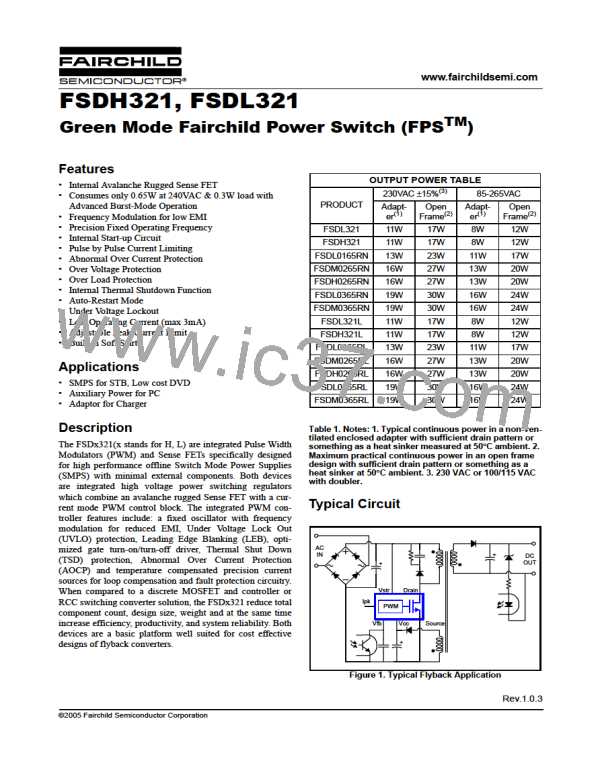FSDH321, FSDL321
Cfb from 3V to 6V with 5uA.
tection) circuit as shown in figure 7. When the gate turn-on
signal is applied to the power Sense FET, the AOCP block is
enabled and monitors the current through the sensing resis-
tor. The voltage across the resistor is then compared with a
preset AOCP level. If the sensing resistor voltage is greater
than the AOCP level, pulse by pulse AOCP is triggered
regardless of uncontrollable LEB time. Here, pulse by pulse
AOCP stops Sense FET within 350nS after it is activated.
Vcc
8V
OLP
6V
FPS switching
Following Vcc
4.4 Over Voltage Protection (OVP) : In case of malfunc-
tion in the secondary side feedback circuit, or feedback loop
open caused by a defect of solder, the current through the
opto-coupler transistor becomes almost zero. Then, Vfb
climbs up in a similar manner to the over load situation, forc-
ing the preset maximum current to be supplied to the SMPS
until the over load protection is activated. Because excess
energy is provided to the output, the output voltage may
exceed the rated voltage before the over load protection is
activated, resulting in the breakdown of the devices in the
secondary side. In order to prevent this situation, an over
voltage protection (OVP) circuit is employed. In general,
Vcc is proportional to the output voltage and the FPSTM uses
Vcc instead of directly monitoring the output voltage. If
3V
Delay current (5uA) charges the Cfb
t1
t2
t3
t4
t
1
RC
V (t1)
R
t1 = −
In (1 −
); V (t1) = 3V , R = 2.8KΩ, C fb = C
;Idelay = 5uA,V(t1+t2) −V(t1) = 3V
fb
_ fig .2
fb
(V(t1+t2)−V(t1))
t2 = Cfb
Idelay
Figure 6. Over load protection
V
CC
exceeds 19V, OVP circuit is activated resulting in ter-
4.2 Thermal Shutdown (TSD) : The Sense FET and the
control IC are integrated, making it easier for the control IC
to detect the temperature of the Sense FET. When the tem-
perature exceeds approximately 140°C, thermal shutdown is
activated.
mination of the switching operation. In order to avoid undes-
ired activation of OVP during normal operation, Vcc should
be properly designed to be below 19V.
5. Soft Start : The FPSTM has an internal soft start circuit
that increases the feedback voltage together with the Sense
FET current slowly after it starts up. The typical soft start
time is 15msec, as shown in figure 8, where progressive
increments of Sense FET current are allowed during the
start-up phase. The pulse width to the power switching
device is progressively increased to establish the correct
working conditions for transformers, inductors, and capaci-
tors. The voltage on the output capacitors is progressively
increased with the intention of smoothly establishing the
required output voltage. It also helps to prevent transformer
saturation and reduce the stress on the secondary diode.
4.3 Abnormal Over Current Protection (AOCP) :
PWM
COMPARATOR
Vfb
CLK
Drain
LEB
Out Driver
Vsense
AOCP
COMPARATOR
S
Q
R
Rsense
V
AOCP
Drain current
[A]
Figure 7. AOCP Function & Block
0.7A
0.4A
Even though the FPSTM has OLP (Over Load Protection)
and current mode PWM feedback, these are not enough to
protect the FPSTM when a secondary side diode short or a
transformer pin short occurs. In addition to start-up, soft-
start is also activated at each restart attempt during auto-
restart and when restarting after latch mode is activated. The
FPSTM has an internal AOCP (Abnormal Over Current Pro-
Tss
11

 FAIRCHILD [ FAIRCHILD SEMICONDUCTOR ]
FAIRCHILD [ FAIRCHILD SEMICONDUCTOR ]